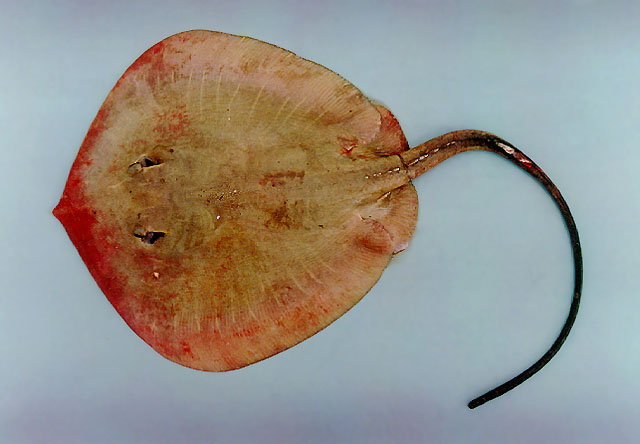| Dasyatidae (Stingrays), subfamily: Dasyatinae |
| 62 cm WD (male/unsexed); max.weight: 6,000.0 g |
|
demersal; freshwater, potamodromous |
| Southeast Asia: endemic to the Mekong River (Cambodia and Thailand); introduced to Chao Phraya River (Thailand). |
|
Dorsal spines (total): 0-0; Dorsal soft rays (total): 0-0; Anal spines: 0-0; Anal soft rays: 0-0. Distinguished from the other stingray species in the Mekong basin by the presence of a ventral and a dorsal skin folds on the tail and the bright orange color of the ventral surface of the disc. The middle disc is whitish with scattered large orange spots. The dorsal surface of the disc is brown (Ref. 27732). Disc longer than wide; tail longer than body (Ref. 12693). Lacking caudal fin; with long whip-like tail (Ref. 43281). |
| Obligate freshwater stingray that occurs over sandy substrate in large rivers. Feeds on bottom-dwelling invertebrates (Ref. 12693). Ovoviviparous (Ref. 50449). Marketed fresh (Ref. 32457). |
|
Endangered (EN); Date assessed: 25 January 2021 (A2bcd) Ref. (130435)
|
| harmless |
|
Known from the Mekong basin (Ref. 9840, 27732) in the Nakornpanom Province (Ref. 32444) and in Ban Hang Khone, a village on an island in the middle of the mainstream Mekong River just below the Great Khone Waterfalls in Champasak Province (Ref. 37767). Reported also to occur in the Mekong above the great waterfalls (Ref. 9497). Fishermen at Ban Hang Khone recognize only one large species of pa fa hang or stingray, attaining 30 kg or more (presumably Dasyatis laosensis) (Ref. 9497). Museum: Mekong river at Ban Hang Khone, just below Khone Falls, CAS 93987 (Ref. 5515). Also Ref. 9840, 12693, 30857, 56905. |
Source and more info: www.fishbase.org. For personal, classroom, and other internal use only. Not for publication.

